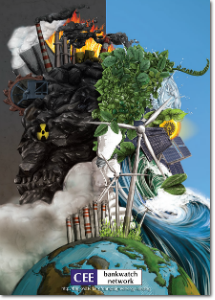The European Investment Bank’s energy lending: stuck in the past or facing the future?
The European Investment Bank, the house bank of the European Union, which directs a fifth of its annual lending portfolio of 60 to 70 billion euros to energy projects, is currently reviewing the policy document that guides its lending to the power sector. On this occasion, Bankwatch is publishing a poster of positive and negative examples of the bank’s lending to energy projects.
23 May 2013

The EIB’s beneficial and harmful energy projects
Brussels – The European Investment Bank, the house bank of the European Union, which directs a fifth of its annual lending portfolio of 60 to 70 billion euros to energy projects, is currently reviewing the policy document that guides its lending to the power sector. On this occasion, Bankwatch is publishing a poster of positive and negative examples of the bank’s lending to energy projects.
Earlier this year, the EIB lent around half a billion euros for a new 600 MW lignite plant at Sostanj in Slovenia despite the project’s disastrous climate and health impact and corruption allegations surrounding its management. This is one of several coal projects financed by the EIB within the remit of its current energy policy, published in 2007. Apart from coal, the bank has lent for gas and oil projects as well as for transmission lines to import electricity from nuclear power into Europe from Ukraine.
Such lending is incompatible with the objective of decarbonising the European economy by 2050 and with climate science which urges keeping fossil fuels in the ground.
On the bright side, the EIB has increasingly committed more resources to energy efficiency projects, notably for the rehabilitation of housing stocks in Romania, Germany and Spain.
Despite progress on energy efficiency and renewables however, the bank’s lending since 2007 is far from shiny: 19 billion euros were lent between 2007 and 2011 to fossil fuels compared to only 5 billion for energy efficiency.
More can be done, and the positive examples included in the Bankwatch poster are an illustration of what the institution’s energy portfolio should look like.
“Any replacement in energy generation after 2013 for coal and 2014 for gas should be turned down by the EIB on the basis of climate science and the economic assessment of external costs of fossil fuel projects,” comments Anna Roggenbuck, Bankwatch EIB coordinator and author of the poster. “This needs to be spelled out in the bank’s new energy policy that will come out later on this year. The EU’s bank must stop lending to fossil fuels in order to truly support the fight against climate change.”
Notes for the editors:
See a presentation of the Bankwatch poster here:
https://bankwatch.org/EIB-energy-future-past
Also in PDF:
https://bankwatch.org/sites/default/files/EIBenergy-futurepast.pdf
Read a briefing on European public bank’s energy lending:
https://bankwatch.org/sites/default/files/briefing-EnergyLending-22Apr2013.pdf
More about energy lending by European public banks:
https://bankwatch.org/campaign/energy-lending
More about the new EIB energy policy:
http://www.eib.org/about/partners/cso/consultations/item/public-consultation-on-eibs-energy-lending-policy.htm
For more information, contact:
Anna Roggenbuck
Bankwatch EIB coordinator
annar at bankwatch.org
+ 48 509 970 424
Never miss an update
We expose the risks of international public finance and bring critical updates from the ground – straight to your inbox.
Institution: EIB
Theme: Energy & climate
Tags: EIB | coal | energy efficiency | energypolicy | fossil fuels | infographic | renewables | visualisation
